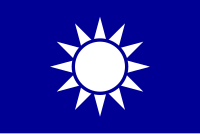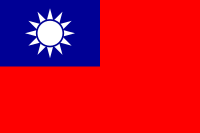Dang Guo
This article includes a list of references, related reading, or external links, but its sources remain unclear because it lacks inline citations. (April 2022) |
Dang Guo (Chinese: 黨國; pinyin: Dǎngguó; lit. 'party-state'), also known as Tang Kuo, was the one-party system adopted by the Republic of China (ROC) under the Kuomintang, lasting from 1924 to 1987. It was adopted after Sun Yat-sen acknowledged the efficacy of the nascent Soviet Union's political system, including its system of dictatorship. Chiang Kai-shek later used the Kuomintang to control and operate the Nationalist government and the National Revolutionary Army. All major national policies of the government bureaucracy were formulated by the Kuomintang, giving the party supreme power over the whole nation.
Following the beliefs of Sun Yat-sen, political power should have been returned to the people after the National Revolutionary Army militarily ended the Warlord Era. However, martial law in Taiwan continued from 1949 until 1987, during which other political parties were banned. Martial law was lifted in 1987 by president Chiang Ching-kuo, a move that legalized other political parties such as the Democratic Progressive Party and ended the Dang Guo era.
Origin
[edit]Dang Guo was short for Yi Dang Zhi Guo (以黨治國), which literally means "using the political party to run the state". In 1920, Sun Yat-sen, founding father of the Republic of China, made Dang Guo the official ROC national policy during the phase of military rule and political tutelage (two of the three phases of the Fundamentals of National Reconstruction). He was influenced by Leninist ideology, which led to the October Revolution in Russia. According to Sun, the Kuomintang should be paramount over the Republic of China in the course of revolution (war against the warlords) and should issue orders to the ROC bureaucracy, all NGO groups, and indeed to all individuals.
In 1924, Sun said:
- 當俄國革命時,用獨裁政治,諸事一切不顧,只求革命成功……,其能成功,卽因其將黨放在國上。我以爲。應重新組織,把黨放在國上 。
- Dāng éguó gémìng shí, yòng dúcái zhèngzhì, zhūshì yīqiè bùgù, zhǐ qiú gémìng chénggōng ..., Qí néng chénggōng, jí yīn qí jiāng dǎng fàng zài guó shàng. Wǒ yǐwèi. Yīng chóngxīn zǔzhī, bǎ dǎng fàng zài guó shàng.
- During the Russian Revolution, political dictatorship was used, everything else can be discarded, the only aim was the success of the revolution ... its success was because the party (Russian Communist Party (Bolsheviks)) was on top of the state. I suggest ... we should reorganize by putting the party (Kuomintang) on top of the state (ROC).
In practice
[edit]
After Sun Yat-sen decided to follow and copy the Soviet political system, his successor Chiang Kai-shek used the Kuomintang to control and operate both the Nationalist government and the National Revolutionary Army, which was sometimes called "The Party's Army" (黨軍). The ROC bureaucracy had then become the means and the tools of Kuomintang, where all the major national policies were formulated, while resulted in the party holding the supreme power of the whole nation.
The concept of Dang Guo was an outgrowth of Sun's concept of "political tutelage" during which the Kuomintang was to lead the state and to instruct the people on how the democratic system would work prior to the transition to full democracy.
Under Dang Guo, ROC military personnel and civil servants alike were expected to owe their allegiance to Kuomintang first and the state second, a policy reflected by such phrases as "Service to the Party and the Nation" (功在黨國) and in the national anthem, which makes an explicit reference to "Our Party". Likewise, the emblem of the Kuomintang was used as the emblem of the state, and the flag of the Kuomintang has been used as the naval jack to this day.
The Kuomintang unified China in 1927 and started to prepare the state for democracy, as according to Sun's teaching. The Constitution of the Republic of China, enacted in 1947, stipulates that different parties shall enjoy equal status, and the National Revolutionary Army was returned to civilian control as the Army of the Republic of China. However, the outbreak of the Chinese Civil War caused the ROC to be under military rule of the KMT during the period of mobilization when the ROC government relocated to Taiwan in 1949.
After martial law ended in 1987, all political parties became legal, and the Republic of China was democratized. Since then, the President of the Republic of China has been democratically elected by the people of Taiwan. In 2000, Chen Shui-bian of the Democratic Progressive Party was elected as the first non-KMT president under the Constitution.
See also
[edit]- Chinese state nationalism
- Democratic centralism (Kuomintang)
- Neoauthoritarianism
- Particracy
- Party-state capitalism
- Transitional Justice Commission
- Wild Strawberry student movement
Sources
[edit]- Xia, Ming. "The Communist Party of China and the "Party-State"". The New York Times.
- 张英洪:孙中山的以党治国思想 (in Chinese) (Google translation)
- 孙中山“以党治国”思想的形成及其影响 (in Chinese)
- 吴敏:以党治国是国民党的遗毒 (in Chinese) (Google translation)
- 浅议孙中山的民主宪政思想对当代中国民主政治与国家现代化的启示 作者:李昌庚 (in Chinese)[permanent dead link] (Google translation)



